MARIANI’S
Virtual Gourmet
May 8, 2016
NEWSLETTER
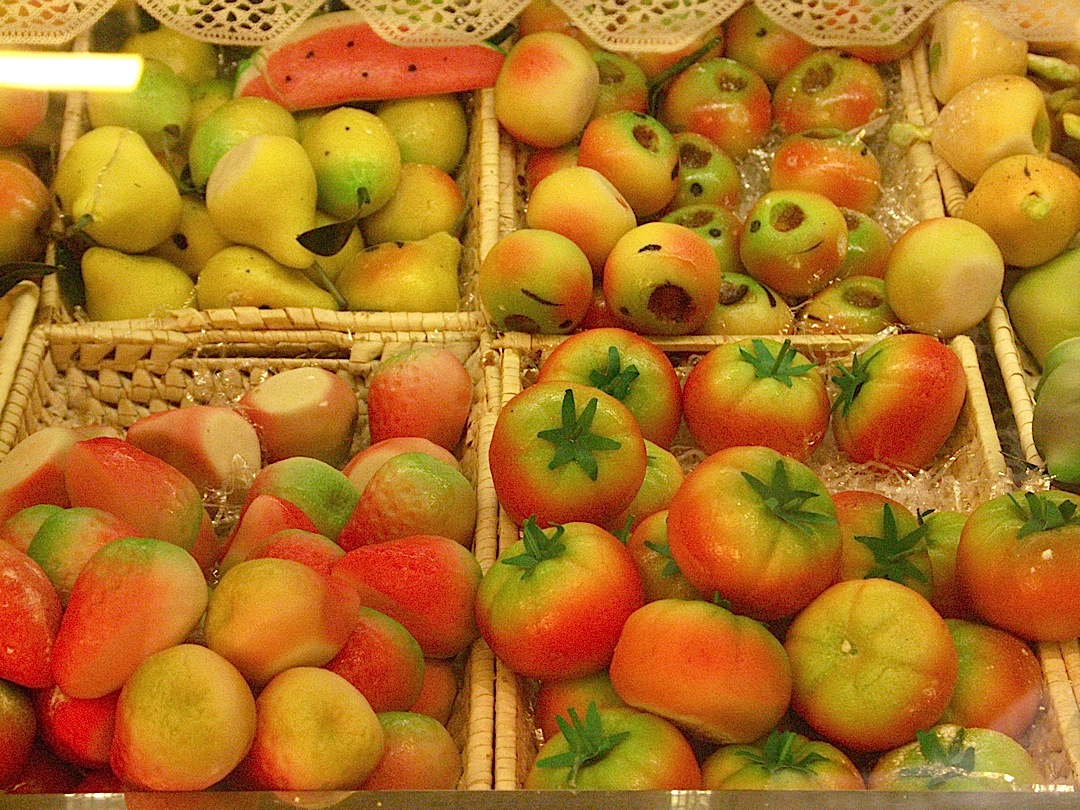
❖❖❖
IN THIS ISSUE
SOUTH AFRICA, Part Two
BY BRIAN FREEDMAN
NEW YORK CORNER
NAI TAPAS BAR
By John Mariani
NOTES FROM THE WINE CELLAR
CARMEL VALLEY WINERIES
By Geoff Kalish
❖❖❖
SOUTH AFRICA, Part Two
BY BRIAN FREEDMAN

Dinner at Bosman’s Restaurant
is a classic affair (below) yet still electrified
with the kind of unexpected twists that make
return visits a good idea.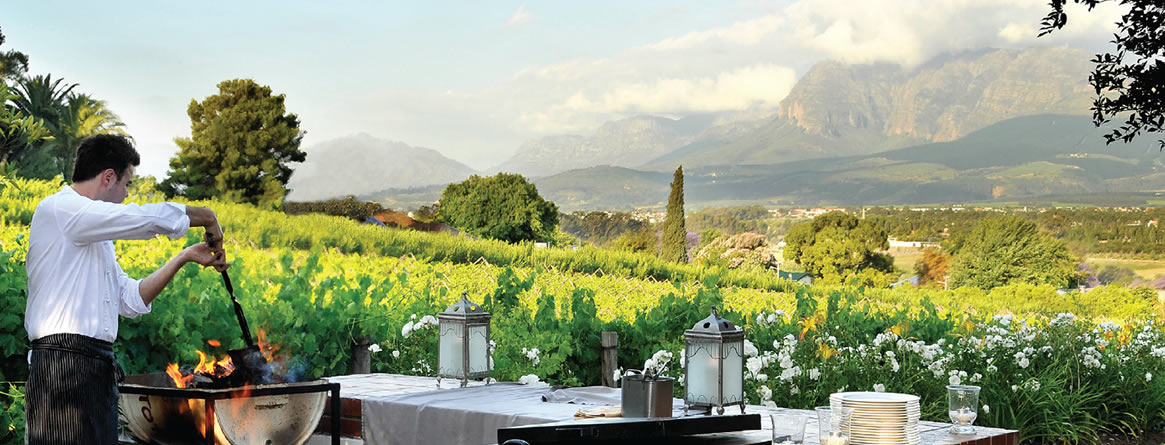
Set in the elegant dining room off the lobby in the Manor House of the five-star Grande Roche hotel in Paarl, with Paarl Rock rising in the distance, the cuisine here, from Executive Chef Roland Gorgosilich, features dishes like a jus-glazed ostrich filet with bread dumpling, mushroom velouté and cranberry gel; and springbok loin, poached sous vide, accompanied by a cocoa jus and hazelnut sponge, as well as parsnip puree and figs.
There is also highly professional wine service
from an extensive list. Camps Bay, in Cape Town,
is home to the Leopards Bar at 12
Apostles.
Sundowners—exactly what you think: cocktails at
the end of the day—are a leisurely experience
there, with the sun dipping toward the water
glistening beneath the balcony of the bar, the
iconic Table Mountain in the distance, a lovely
selection of bites and fuller meals and deep lists
of spirits, cocktails, wines and cigars.
Impeccably fresh prawn 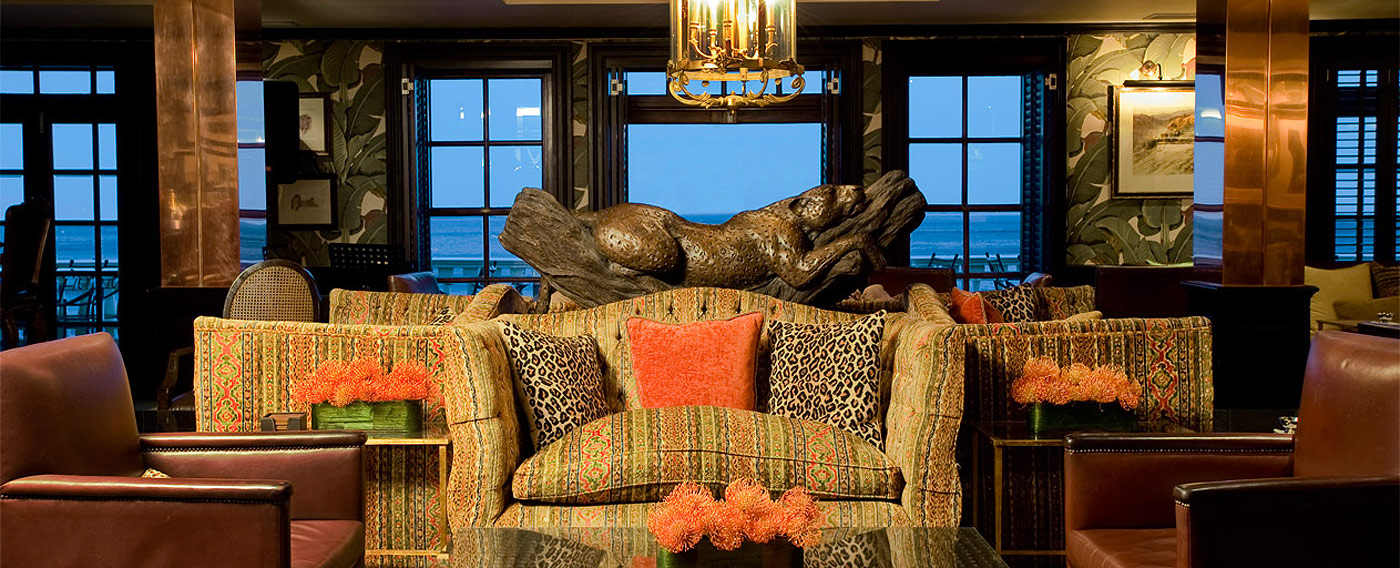 tempura, the house
signature drink, the Lazy Leopard, made with
pineapple juice, spiced rum, and MCC sparkling
wine, and more, make for a perfect end to the day.
The evening I visited, a local musician began
playing, at one point, George Ezra’s “Budapest” on
the guitar, his rendition easily the equal of
Ezra’s original.
tempura, the house
signature drink, the Lazy Leopard, made with
pineapple juice, spiced rum, and MCC sparkling
wine, and more, make for a perfect end to the day.
The evening I visited, a local musician began
playing, at one point, George Ezra’s “Budapest” on
the guitar, his rendition easily the equal of
Ezra’s original.
In Cape Town, dining runs the gamut from the casual
to the formal, as you’d expect in an increasingly
important business and tourism hub of wonderfully
distinct neighborhoods. Kloof Street House
(below)
with its funky interior that reminded me of New
Orleans, was 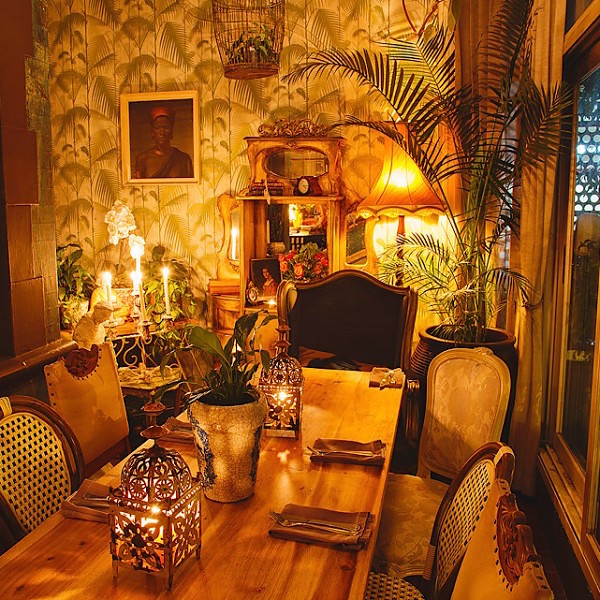 bursting with the energy
of all the stylish, beautiful Capetonians who come
there to dine and be seen. Its casual vibe, however,
had behind it a menu of attentively prepared dishes,
ranging from the pan-fried halloumi with toasted
seeds and charred cauliflower to the excellent KSH
burger, crafted from meltingly tender Wagyu beef,
anchored further by truffle-perfumed wild mushrooms
and livened up with a bright hit of pickled red
onion.
bursting with the energy
of all the stylish, beautiful Capetonians who come
there to dine and be seen. Its casual vibe, however,
had behind it a menu of attentively prepared dishes,
ranging from the pan-fried halloumi with toasted
seeds and charred cauliflower to the excellent KSH
burger, crafted from meltingly tender Wagyu beef,
anchored further by truffle-perfumed wild mushrooms
and livened up with a bright hit of pickled red
onion.
A meal at the gorgeous Belmond Mount Nelson Hotel, in the Planet Restaurant under the care of Chef Rudi Liebenberg, is a wonderful way to see how local ingredients—from grilled springbok loin with cumin, labneh, roasted baby beetroot, morogo (a wild African spinach) and a braised shank croquette to curry-leaf butter-poached crayfish—can be transformed into dishes both luxurious and playful.
Over
at the expansive Victoria and Alfred Waterfront, the
swanky Baia Seafood
Restaurant (right) serves
up a fantastic local bounty, including prawns
seemingly any way you can imagine and an excellent
dish of ginger- and coriander-spiced kingklip, a
local delicacy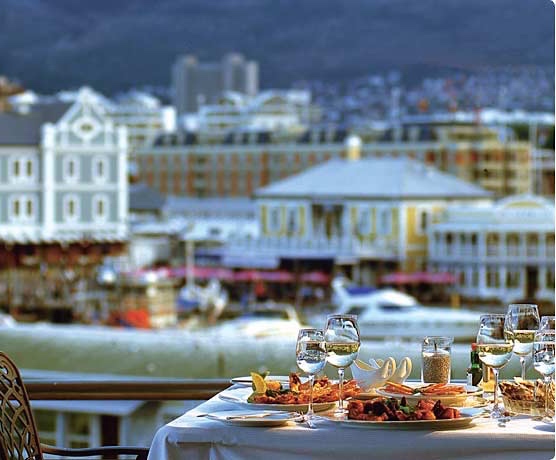 that’s related to eel. At the
Table Bay Hotel, high tea is required, as it’s one
of the more elaborate afternoon reposes I’ve had
anywhere in the world. With a sweets table as large
as my home kitchen and as colorful as a South
African sunset (the rainbow-colored cheesecake is a
must), and a multi-course menu of savory delicacies
like scones, tartlets and more, all of which can be
expertly paired with the appropriate teas, this is
the afternoon ritual as it was meant to be.
that’s related to eel. At the
Table Bay Hotel, high tea is required, as it’s one
of the more elaborate afternoon reposes I’ve had
anywhere in the world. With a sweets table as large
as my home kitchen and as colorful as a South
African sunset (the rainbow-colored cheesecake is a
must), and a multi-course menu of savory delicacies
like scones, tartlets and more, all of which can be
expertly paired with the appropriate teas, this is
the afternoon ritual as it was meant to be.
No serious food lover should miss indulging in
what must be one of the great yet
all-too-unfamiliar cuisines of the world: Cape
Malay. Its roots go back to the arrival of
Malaysian Muslims, who founded as their epicenter
in the city the Bo-Kaap neighborhood, the houses
painted colors so vibrant they seem almost
electric. The flavors of Cape Malay food will be
more or less familiar to lovers of Indian and
South East Asian dishes, yet it is definitely its
own cuisine.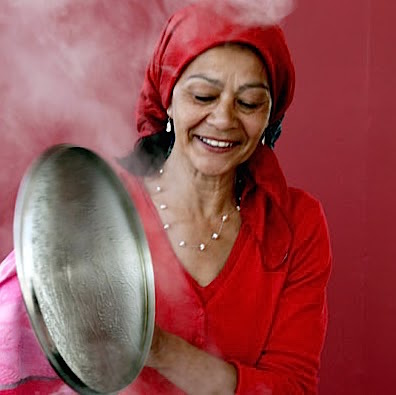 We spent several hours with Zainie Misbach (left),
affectionately known as Auntie Zainie, who is not
only one of the great preservers of this fabulous
culinary heritage, but also a passionate
ambassador for it. She runs the Bo-Kaap
Cooking Tour cooking classes from her
elegant, inviting home, where she and
student-visitors cook up curries and daltjies
and samosas whose
ingredients were purchased in the neighborhood.
We spent several hours with Zainie Misbach (left),
affectionately known as Auntie Zainie, who is not
only one of the great preservers of this fabulous
culinary heritage, but also a passionate
ambassador for it. She runs the Bo-Kaap
Cooking Tour cooking classes from her
elegant, inviting home, where she and
student-visitors cook up curries and daltjies
and samosas whose
ingredients were purchased in the neighborhood.
Then,
of
course, there is the wine industry of South
Africa, which has been on the ascent for years
now. I’ve always been a fan of the wines, but
never realized how many more styles there are than
what most wine lists feature on the other side of
the Atlantic. Ask most Americans what they think
of the wines of South Africa, and they’ll
immediately start talking about Chenin Blanc and Pinotage.
The truth of the country’s wine industry, however,
is quite different. Yes, there are plenty of
excellent bottlings of those two most emblematic
grape varieties, but what surprised me most were
the astounding, delicious Rhône varieties being
grown and vinified there, as well as the excellent
Merlot, Cabernet Franc, and Methode Cap Classique
sparklers. South Africa, then, is a country
utterly overflowing with life, and energy, and
world-class food and wine to savor. To call it
merely delicious is to vastly understate all that
it has to offer. Personally, I’m thrilled that I
was training for marathons during both trips. It
gave me an excuse to eat and drink to my heart’s
content, not that I really needed any
justification. With a bounty this wide-ranging,
exciting, and memorable, I would have happily
indulged in it all anyway.
Blanc and Pinotage.
The truth of the country’s wine industry, however,
is quite different. Yes, there are plenty of
excellent bottlings of those two most emblematic
grape varieties, but what surprised me most were
the astounding, delicious Rhône varieties being
grown and vinified there, as well as the excellent
Merlot, Cabernet Franc, and Methode Cap Classique
sparklers. South Africa, then, is a country
utterly overflowing with life, and energy, and
world-class food and wine to savor. To call it
merely delicious is to vastly understate all that
it has to offer. Personally, I’m thrilled that I
was training for marathons during both trips. It
gave me an excuse to eat and drink to my heart’s
content, not that I really needed any
justification. With a bounty this wide-ranging,
exciting, and memorable, I would have happily
indulged in it all anyway.
❖❖❖
By John Mariani
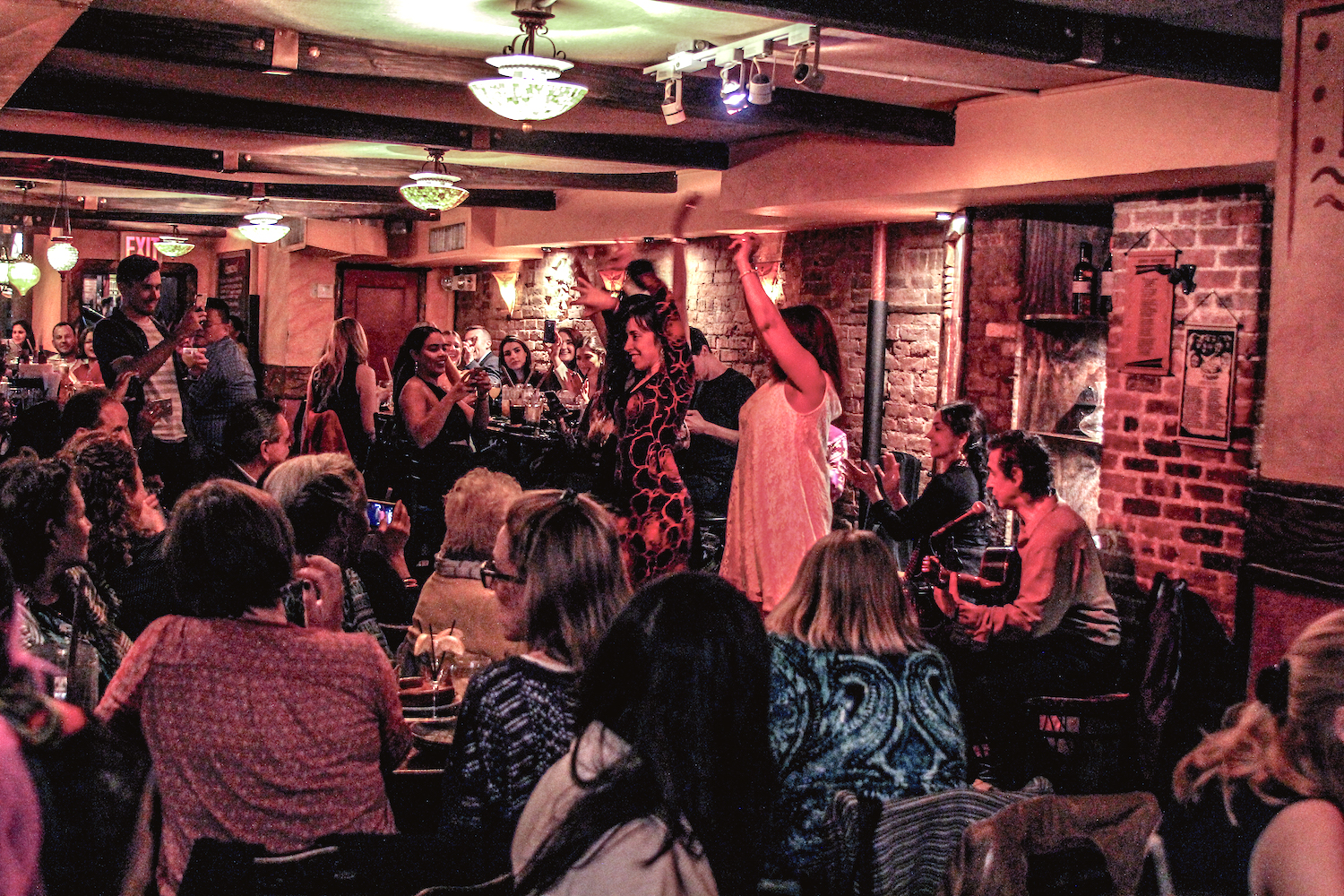 NAI
TAPAS BAR
NAI
TAPAS BAR174 First Avenue (at 11th Street)
212- 677-1030
naitapas.nyc
In the language of Galicia, Nai means
“mother,” and the owners of this six-year-old
tapas restaurant in the East Village say its
significance is “to
continue the secrets of the most traditional
cuisine ... the cozy feeling of home when you
don’t know where to go.”
In fact, many of
the recipes used at Nai Tapas Bar have been handed
down from Chef Ruben Rodriguez’s grandmother and
mother, while he adds a great deal of his personal
spin on tradition with a few modernist touches
that begin with a perfect rendition of Ferran
Adria’s famous “liquid olive” served on a spoon.
The cozy feeling is evident
when you enter the small dining area, with its
rough wooden ceiling beams, brick walls, high
tables and hanging lanterns. The walnut bar
stretches fifteen feet along one wall. On
weekends it gets seriously loud when live flamenco
music is featured.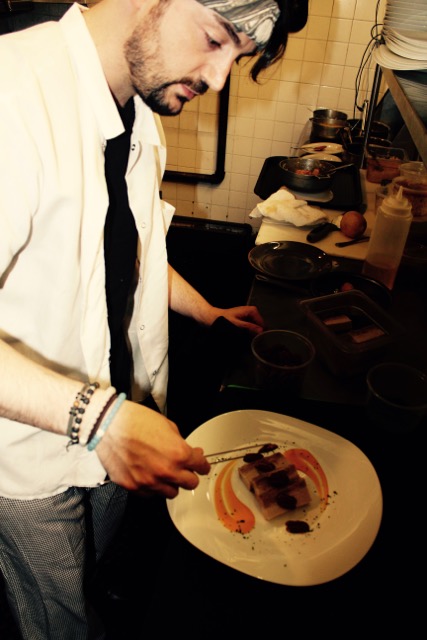
While promoted as a typical
Galician tapas bar with small-portion dishes, Nai
may not be what you expect of the genre—through
not for lack of trying. For one thing, the customary
way tapas is served in Spain is to put many
different small plates on the bar, and people
point to or pick them up, with the bill somehow
totaled by the man behind the counter. That is
not the case at Nai, because the NYC Health
Department would close it down in a second for
having fresh food displayed without a shield of
glass.
Also, since Nai has only a
beer-and-wine license, you can’t enjoy Spanish
brandies or Sherries or any other kind of booze,
so not even the sangria contains any. There
is a very decently priced wine list of mostly
Spanish wines, as well as 25 beers, and specialty
drinks with names like Calimocho (red wine and
Coca-Cola) and Tinto de Verano (red wine with 7-Up
and lemon) at just $6. So it is odd that they
don’t carry the quintessential tapas bar fizzy
wine call txakoli, though owner and general
manager David
Martinez insists they will soon have a
selection when the restaurant expands upstairs.
Our party left the array
of dishes from the menu entirely to be chosen by
Chef Rodriguez (right),
a wise decision because sticking too close to the
kinds of predictable items you’d find elsewhere
would rob you of the pleasures of his new ideas. Case in
point is his tostada
de lubina,
morsels of soft Chilean sea bass (which is not
really a bass but a cod, unlike true lubina, which
is) wrapped in toast then topped with an orange
emulsion and balsamic reduction, finished off with
a shake of saffron salt ($14). The
very traditional dish of gambas al
ajillo, fat shrimp served in a rich garlic
and oil sauce ($8/14.50), followed, then aguacate
relleno ($10), an avocado stuffed with crab
meat and sprinkled with Serrano ham—two quite
simple dishes in the tapas style.
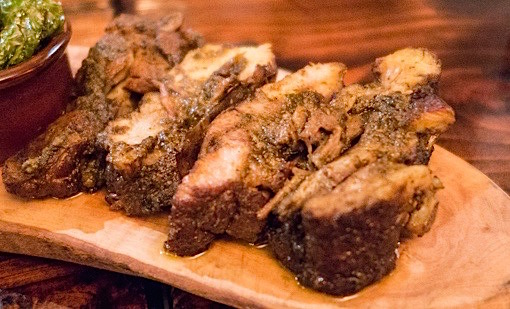 But pollo
ahumado ($12) goes a bit further,
glazing smoked chicken thighs cooked by Sous-vide
and served on skewers. Coles de
bruselas (Brussels sprouts) come spiked
with a mustard aïoli ($10), while one of the most
popular dishes at Nai is a small masterpiece of
protein, fat, crunch and heat--barriga de cerdo, pork belly with
caramelized pecans and yucca chips over sweet
carrot cream ($12). Salmorejo
canario ($14) are well marinated, meaty
baby back ribs (left)
with cabrales potatoes and slick fried peppers,
gilded with manchego cheese melted over them and a
quail’s egg on top.
Pintxo
de chistorra is a Basque item made with
spicy Basque chorizo over piquillo peppers on
toast topped with melted manchego cheese and quail
egg. It’s
a complicated assemblage but every element works
beautifully to complement the other.
But pollo
ahumado ($12) goes a bit further,
glazing smoked chicken thighs cooked by Sous-vide
and served on skewers. Coles de
bruselas (Brussels sprouts) come spiked
with a mustard aïoli ($10), while one of the most
popular dishes at Nai is a small masterpiece of
protein, fat, crunch and heat--barriga de cerdo, pork belly with
caramelized pecans and yucca chips over sweet
carrot cream ($12). Salmorejo
canario ($14) are well marinated, meaty
baby back ribs (left)
with cabrales potatoes and slick fried peppers,
gilded with manchego cheese melted over them and a
quail’s egg on top.
Pintxo
de chistorra is a Basque item made with
spicy Basque chorizo over piquillo peppers on
toast topped with melted manchego cheese and quail
egg. It’s
a complicated assemblage but every element works
beautifully to complement the other.
Nai carries an array of Spanish
hams and cheeses too; a selection is $19.
We prepared for dessert with an
icy sandia
impregnada con Sangria infused with
watermelon, then came a kind of pear cotton candy
called caramelo
de algodon and that most Spanish of all
desserts, the piping hot fritters called churros,
only at Nai they are filled with chocolate rather
than dipped in it—a cute, tasty trick for a
dinner’s end.
There’s nothing gimmicky about
Nai’s food, and Chef Rodriguez’s
ideas are all intended to deliver flavor not just
surprise. His
cuisine may be in the line of modernism Ferran
Adria put in motion, but shocking his patrons is
in no sense what Rodriguez wants. He
wants you back, and only if you remember the
pleasures of Nai’s flavors and aromas would
you do so.
Nai is open for lunch Sat. &
Sun., for dinner nightly.
❖❖❖
CARMEL VALLEY WINERIES
By Geoff Kalish
Visitors to the
Monterey Peninsula often flock to picturesque
Carmel-by-the-Sea, where typical tourist shops,
upscale emporiums like Tiffany’s and Bottega
Veneta, winery tasting rooms, and a range of
restaurants dot the streets of the barely
one-square-mile village, and pace often
frenetic. Those who sojourn to the area to relax
and/or just taste wine usually head to Carmel
Valley, with its low-key roadside village and
nearby areas featuring over 20 winery tasting
rooms and the newly renovated, spectacular, yet
tranquil Bernardus Lodge & Spa.
Bernardus Winery
5
Carmel Valley Road
831-659-1900
www.bernardus.com
Over 25 years ago, when Dutch race car driver Ben
Pon started this winery, few thought that Carmel
Valley area could produce premium wine and there
were no tasting rooms in the area. Now managed by
Matt Shea and American-born, French-trained
winemaker Dean DeKorth, Bernardus routinely
releases over 50,00 cases a year of premium wine,
and they are only one of over 20 tasting rooms in
the area. “Attention to detail, with sustainable
vineyard practices, hand-picking, continued
experimentation and a philosophy of producing
wines that are as natural and unmanipulated as
possible,” is what Pon, Shea and DeKorth feel accounts
for their success, with new releases routinely
winning multiple awards.
A
Sampling of Recent Releases
2012 Santa Lucia Highlands Pinot Noir
($26)--This recent FiftyBest Gold Medal winner has
a bouquet of ripe cherries and plums, with hints
of chocolate and a well-integrated taste of ripe
berries, spice and oak with a long, memorable
finish.
2010 Marinus
($65)--This Bordeaux-like blend of Cabernet
Sauvignon, Merlot, Cabernet Franc, Petit Verdoit
and Malbec from a single vineyard (Marinus – after
Mr. Pon’s middle name), shows a bouquet and taste
of cassis and anise spice and a long finish with
hints of cherries and a touch of tannin.
2013 Sauvignon Blanc (($20)--Made from
primarily Sauvignon Blanc and a small amount of
Semillon grapes (all from Griva Vineyard in the
Arroyo Secco area) this wine has a bouquet and
taste of grapefruit and ripe melons, with a hint
of lime and a vibrant, refreshing finish.
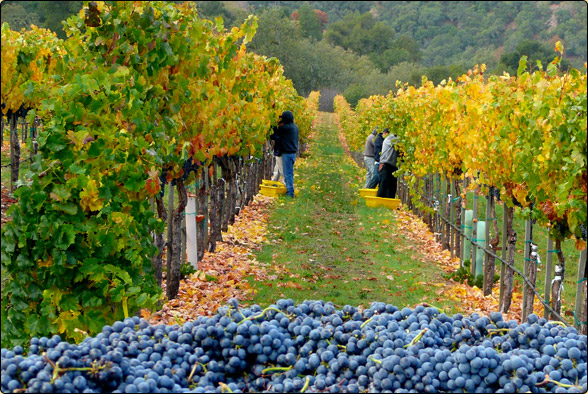 Joullian
Joullian
2
Village Drive
831-659-8100
www.joullian.com
Founded by the Joullian and Sias families of
Oklahoma City in 1982, this boutique winery, producing
6,000 – 8,000 cases of primarily Bordeaux-blend
wine a year, has
been managed by Stanford graduate Ridge Watson
(brother of golfer Tom Watson) since its
inception. Completed in 1992 the winery has the
capability to handle each of the vineyard blocks
of grapes separately “so that the complex
subtleties and nuances in the field could be
transferred into the bottle,” state the owners.
A
Sampling of Recent Releases
2009 Carmel Valley Estate Cabernet
Sauvignon
($32)--Made from a blend of Cabernet Sauvignon
(83%), Merlot (15%) and Cabernet Franc (12%) this
wine shows a
bouquet and taste of cassis and
blackberries with hints of ripe cherries in its
smooth, pleasant finish.
2012 Merlot ($35)--This wine has a fragrant bouquet
of cassis and a mouthfilling taste of ripe plums
and cherries with a long smooth finish. Pair this
wine with fare ranging from hamburgers and grilled
steak to baked chicken and veal chops.
2014 Sauvignon Blanc ($26)--Blended with
20% Semillon, this wine has a bouquet and taste of
pears and ripe reaches with a vibrant citrusy
finish.
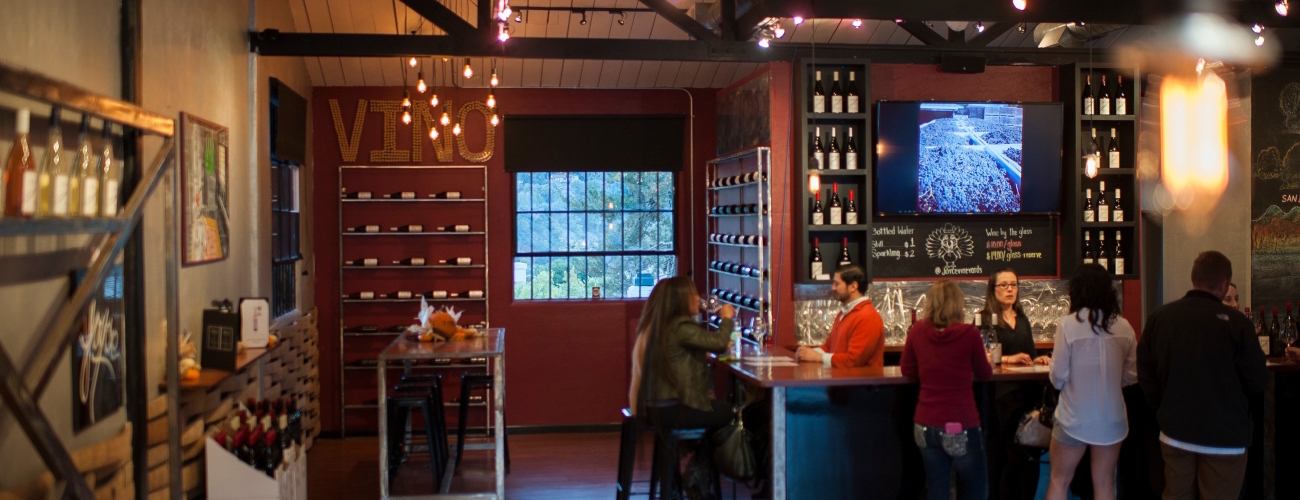 Joyce
Joyce
21
East Carmel Valley Road
831-659-2883
www.joycevineyards.com
What started out as a hobby in the 1980’s for
former race-car driver and dentist Francis Joyce has
developed into a small production winery (9,000
cases annually), run by Russell Joyce (Francis’s
eldest son).
And while each year they produce over a
dozen different labels, they “strive to produce
wines that each show balance and complexity. As a
testament to this philosophy, the demand for
production has increased to such an extent over
the past few years that the winemaking facility
outgrew its Carmel Valley location and is now
situated in larger quarters in Salinas.
A
Sampling of Recent Releases
2013
Tondre Grapefield Pinot Noir (Santa Lucia
Highlands) ($38)--Made from
grapes harvested in the early morning hours,
cold-soaked before 14 days of fermentation, this
FiftyBest Double Gold Medal winner shows
a floral bouquet of cherries and strawberries,
with a jammy taste of ripe strawberries and
cranberries and hints of exotic spices in the
finish.
2014
Pinot Blanc
($25)--This refreshing wine has a fruity bouquet
and taste of pears and peaches with a dry,
vibrant finish.
2011
Estate Reserve Merlot
($50)--This is a not-to-be-missed Merlot, with a
bouquet of cassis and boysenberries and a
well-integrated taste of blackberries
and oak with hints of anise and chocolate in the
long finish.
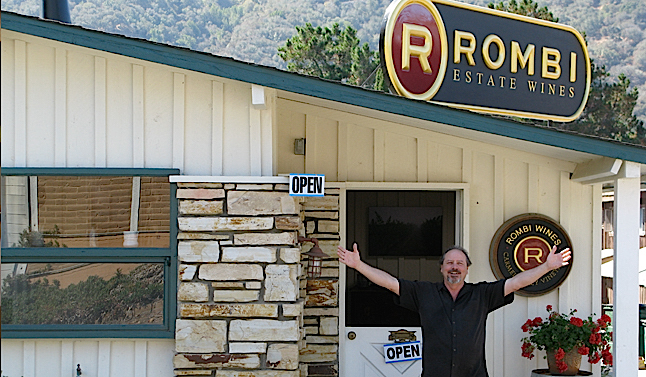 Rombi
Carmel Valley Vineyard
Rombi
Carmel Valley Vineyard
1
Center Street, Carmel Valley Village
831-659-8100
www.RombiWines.com
Don’t expect to find any Rombi wines at retail
wine shops or on restaurant lists. Retired realtor
Sal Rombi only makes 150 cases a year and sells
his entire production at the tasting
room or on line. And if you happen to be in the
area, it’s well worth a visit to his tasting room
(where he presides) and after a sip or two you may
well be convinced to purchase a bottle of his
excellent Estate Cabernet Sauvignon and/or Merlot,
with grapes from a picturesque vineyard set high
in the hills and surrounded by thick woodlands.
A
Sampling of Recent Releases
2011 Rombi Estate Merlot ($65)--With a bouquet
and taste of cassis and black currants with hints
of oak, this wine is perfect to drink now with
lamb and veal.
2010 Rombi Estate Cabernet
($85) –This wine shows a bouquet of plums,
apricots and a hint of tar with a well integrated
taste of ripe berries and oak and a long finish
with a touch of tannin. Drink this wine now with
ripe cheeses or with chicken and veal in a few
years once it matures.
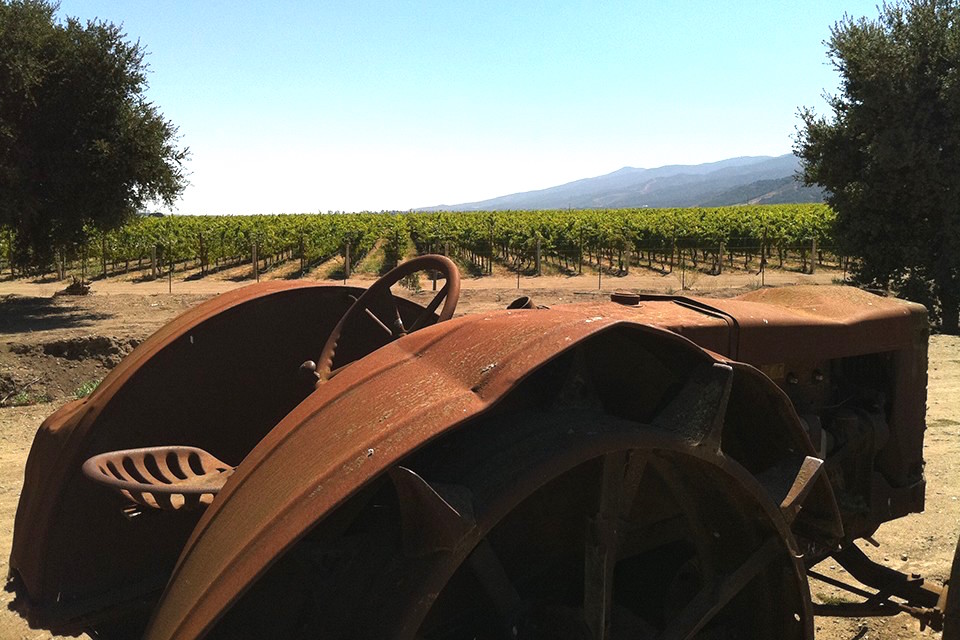 Talbott
Talbott
25
Pilot Road
831-659-3500
www.talbottvineyards.com
In 1950 Robert Talbott, Sr. and his wife Audrey
started a men’s tie business in Carmel that has
grown to an internationally-known producer of
luxury clothing. While on business trips to Europe
with his family, eldest son Robb developed a
passion for French Burgundy wines and decided to
attempt to emulate these in California. In 1982 he
began planting on a cold, windswept Carmel Valley
mountain, that locals told him was too cold and
too difficult to plant to yield even acceptable
grapes. Now
with production over 150,000 cases annually from
grapes grown on the original Diamond T Estate
Vineyard, nearby Sleepy Hollow vineyard
and estate plantings in other “difficult” Monterey
locations Robb has certainly proven the naysayers
wrong – with very popular Burgundian style
Chardonnays and Pinot Noirs that
fulfill his philosophy of being “unique and
exceptional.”
A
Sampling of Recent Releases
2013 Kali Hart Chardonnay ($20)--Named after
Robb’s youngest daughter this wine shows a bouquet
and mouthfilling taste of pineapple and other
tropical fruit with a very fruity finish, that
makes this bottle an excellent aperitif quaff.
2013 Sleepy Hollow Pinot Noir ($42)--Produced from
grapes grown in a vineyard that is cooled by fog
during the day, this deep red wine has a bouquet
of ripe cherries and a complex well-integrated
taste of cherry, plum and cranberry with notes of
vanilla in its finish, perfect to pair with veal
and salmon.
2013 Logan Pinot Noir
($25)--Named after Robb Talbott’s son, this wine
shows a bouquet of cherries and blackberries with
hints of cinnamon and a taste of ripe plums and
cranberries and notes of pepper and vanilla in its
long lasting finish.
❖❖❖
FROM A STUDY DONE BY THE UNIVERSITY OF B.S.
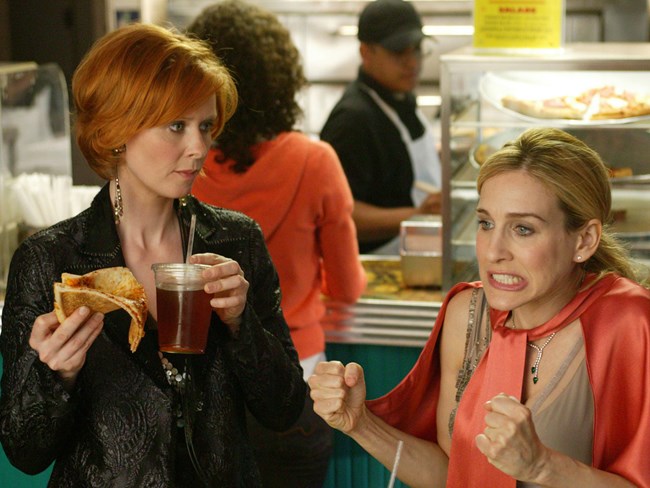
"What
Your
Favorite Pizza Topping Says About Your Personality"
By Phil Mutz,
Littlethings.com
Plain
Pizza--Reliable, Steadfast,
Concerned.
Hawaiian Pizza--Laid-back,
Self-Confident, Quirky.
Anchovy Pizza--Bold,
Unafraid, Stubborn.
Mushroom Pizza--Open, Earthy,
Giving
Pepperoni Pizza--Caring,
Uncomplicated, Fun
Sausage and Pepper Pizza--Balanced, Receptive, Insightful.
Extra Cheese Pizza--Driven,
Indulgent, Goal-Oriented.
Veggie Lovers Pizza--Sensitive,
Secretive. "The Works" Pizza--Indecisive, Welcoming, Excited.

LEVITICUS 7:22: "Thou shall offer a sacrifice with
square hamburgers and cups of Diet Coke to the
Lord."
Can I get an Alleluia?
Christian
evangelist Jerry Falwell, Jr. appeared with Donald Trump
to applaud
the Republican candidate for feeding him Wendy’s instead
of “Champagne and caviar”
while traveling on Trump’s private plane.
A
Masterpiece from Montalcino
By John
Fodera, TuscanVines
I stood in the vineyard.
I smelled the air, the
vines; I
reached down to let the dirt run through my hand and
then allowed the residual dust to permeate the air
around me. A
soft rain began to fall and seemed to introduce yet
another array of aromas. This is the Poggio Alle Mura
vineyard.
Gentle slopes extending from the walls of the
Castello (left)
where clonal optimization has provided the perfect
environment for Sangiovese Grosso. Planted in
1992, the vineyard is just shy of its 25th birthday. Yet when
the subject of today's article was produced, the vines
were only 15 years old. The best from this vineyard is
yet to come.
I wax poetic about the vineyard in
an effort to create a sort of visualization of the
environment so that the reader can perhaps get a
better experience of the way this wine presents itself
in the glass. The
2006 Castello Banfi
Poggio Alle Mura Brunello is a masterpiece. Crafted
from 100% Sangiovese that is vinified in Castello
Banfi's hybrid fermenters, the wine is then enhanced 90% in
French barrique and
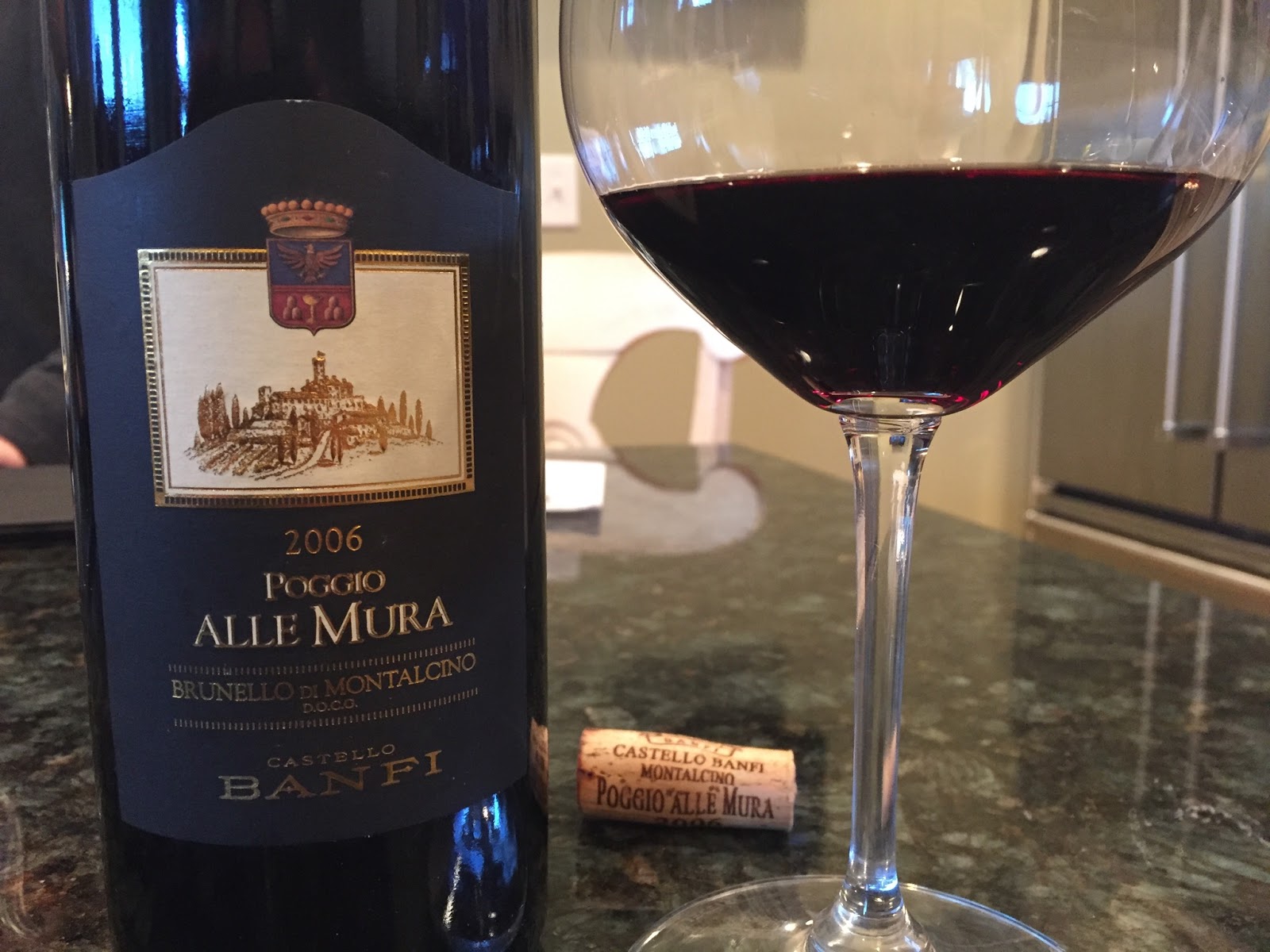 10% in Slavonian Botte before it is
blended, bottle aged for 12 months, and ultimately
released. We
decanted the wine for about 45 minutes and it sang
right from the start.
The aromas are developing nicely and feature a
layer of crushed wild berry, pipe tobacco, flowers,
and that overall Tuscan terroir I attempted to
describe earlier;
dusty red dirt, minerals, cypress, wet stones,
it's complex and intriguing.
10% in Slavonian Botte before it is
blended, bottle aged for 12 months, and ultimately
released. We
decanted the wine for about 45 minutes and it sang
right from the start.
The aromas are developing nicely and feature a
layer of crushed wild berry, pipe tobacco, flowers,
and that overall Tuscan terroir I attempted to
describe earlier;
dusty red dirt, minerals, cypress, wet stones,
it's complex and intriguing.
On the palate the wine is
sensational. It's
aristocratic and modern without losing its soul, which
is Brunello! This
full bodied wine has layers of berry and cherry notes
backed by coffee, earth, tobacco and fresh herbs. Anise,
cured meat and spice notes are peppered throughout. Fresh
acidity, lovely balance and well integrated tannins
that are still slightly chewy round out the picture. While I
loved this with fennel crusted, stuffed pork loin, I believe
this wine will continue to improve. Try one now
if you've got a couple, otherwise wait another 2-3
years. Exceptional
effort. 97
points. Pricing
varies from $60-$80, so shop wisely. A stunning
Brunello that is becoming one of the region’s
benchmarks. Salute!
Any of John Mariani's books below may be ordered from amazon.com.
 The
Hound in Heaven (21st Century Lion Books)
is a novella, and for anyone who loves dogs,
Christmas, romance, inspiration, even the supernatural, I
hope you'll find this to be a treasured favorite.
The story concerns how, after a New England teacher,
his wife and their two daughters adopt a stray puppy found
in their barn in northern Maine, their lives seem full of
promise. But when tragedy strikes, their wonderful dog
Lazarus and the spirit of Christmas are the only things
that may bring his master back from the edge of
despair.
The
Hound in Heaven (21st Century Lion Books)
is a novella, and for anyone who loves dogs,
Christmas, romance, inspiration, even the supernatural, I
hope you'll find this to be a treasured favorite.
The story concerns how, after a New England teacher,
his wife and their two daughters adopt a stray puppy found
in their barn in northern Maine, their lives seem full of
promise. But when tragedy strikes, their wonderful dog
Lazarus and the spirit of Christmas are the only things
that may bring his master back from the edge of
despair. WATCH THE VIDEO!
“What a huge surprise turn this story took! I was completely stunned! I truly enjoyed this book and its message.” – Actress Ali MacGraw
“He had me at Page One. The amount of heart, human insight, soul searching, and deft literary strength that John Mariani pours into this airtight novella is vertigo-inducing. Perhaps ‘wow’ would be the best comment.” – James Dalessandro, author of Bohemian Heart and 1906.
“John Mariani’s Hound in Heaven starts with a well-painted portrayal of an American family, along with the requisite dog. A surprise event flips the action of the novel and captures us for a voyage leading to a hopeful and heart-warming message. A page turning, one sitting read, it’s the perfect antidote for the winter and promotion of holiday celebration.” – Ann Pearlman, author of The Christmas Cookie Club and A Gift for my Sister.
“John Mariani’s concise, achingly beautiful novella pulls a literary rabbit out of a hat – a mash-up of the cosmic and the intimate, the tragic and the heart-warming – a Christmas tale for all ages, and all faiths. Read it to your children, read it to yourself… but read it. Early and often. Highly recommended.” – Jay Bonansinga, New York Times bestselling author of Pinkerton’s War, The Sinking of The Eastland, and The Walking Dead: The Road To Woodbury.
“Amazing things happen when you open your heart to an animal. The Hound in Heaven delivers a powerful story of healing that is forged in the spiritual relationship between a man and his best friend. The book brings a message of hope that can enrich our images of family, love, and loss.” – Dr. Barbara Royal, author of The Royal Treatment.
 |
The Encyclopedia of American Food and Drink by John F. Mariani (Bloomsbury USA, $35) Modesty forbids me to praise my own new book, but let me proudly say that it is an extensive revision of the 4th edition that appeared more than a decade ago, before locavores, molecular cuisine, modernist cuisine, the Food Network and so much more, now included. Word origins have been completely updated, as have per capita consumption and production stats. Most important, for the first time since publication in the 1980s, the book includes more than 100 biographies of Americans who have changed the way we cook, eat and drink -- from Fannie Farmer and Julia Child to Robert Mondavi and Thomas Keller. "This book is amazing! It has entries for everything from `abalone' to `zwieback,' plus more than 500 recipes for classic American dishes and drinks."--Devra First, The Boston Globe. "Much needed in any kitchen library."--Bon Appetit. |
"Eating Italian will never be the same after reading John Mariani's entertaining and savory gastronomical history of the cuisine of Italy and how it won over appetites worldwide. . . . This book is such a tasteful narrative that it will literally make you hungry for Italian food and arouse your appetite for gastronomical history."--Don Oldenburg, USA Today. "Italian
restaurants--some good, some glitzy--far
outnumber their French rivals. Many of
these establishments are zestfully described
in How Italian Food Conquered the World, an
entertaining and fact-filled chronicle by
food-and-wine correspondent John F.
Mariani."--Aram Bakshian Jr., Wall Street
Journal.
"Equal parts
history, sociology, gastronomy, and just
plain fun, How Italian Food Conquered the
World tells the captivating and delicious
story of the (let's face it) everybody's
favorite cuisine with clarity, verve and
more than one surprise."--Colman Andrews,
editorial director of The Daily
Meal.com. "A fantastic and fascinating
read, covering everything from the influence
of Venice's spice trade to the impact of
Italian immigrants in America and the
evolution of alta cucina. This book will
serve as a terrific resource to anyone
interested in the real story of Italian
food."--Mary Ann Esposito, host of PBS-TV's
Ciao
Italia. "John Mariani has written the
definitive history of how Italians won their
way into our hearts, minds, and
stomachs. It's a story of pleasure over
pomp and taste over technique."--Danny Meyer,
owner of NYC restaurants Union Square
Cafe, The Modern, and Maialino.
|
 |
 |
 |
 |
 |
 |
 |
 |
 Everett Potter's Travel Report:
Everett Potter's Travel Report: 
 Eating Las Vegas
JOHN CURTAS has been covering the Las Vegas
food and restaurant scene since 1995. He is
the co-author of EATING LAS VEGAS – The 50
Essential Restaurants (the fourth
edition of which will be published in early
2016), as well as the author of the Eating Las
Vegas web site: www.eatinglasvegas.
He can also be seen every Friday morning as
the “resident foodie” for Wake Up With the
Wagners on KSNV TV (NBC) Channel 3 in
Las Vegas.
Eating Las Vegas
JOHN CURTAS has been covering the Las Vegas
food and restaurant scene since 1995. He is
the co-author of EATING LAS VEGAS – The 50
Essential Restaurants (the fourth
edition of which will be published in early
2016), as well as the author of the Eating Las
Vegas web site: www.eatinglasvegas.
He can also be seen every Friday morning as
the “resident foodie” for Wake Up With the
Wagners on KSNV TV (NBC) Channel 3 in
Las Vegas.

MARIANI'S VIRTUAL GOURMET
NEWSLETTER is published weekly. Editor/Publisher: John
Mariani.
Editor: Walter Bagley. Contributing Writers: Christopher Mariani,
Robert Mariani, Misha
Mariani,
John A. Curtas, Edward Brivio, Mort Hochstein,
Andrew Chalk, Dotty Griffith and Brian Freedman. Contributing
Photographers: Galina Dargery, Bobby
Pirillo. Technical Advisor: Gerry McLoughlin.
To un-subscribe from this newsletter,click here.
© copyright John Mariani 2016

